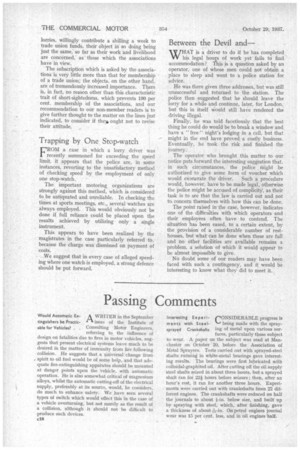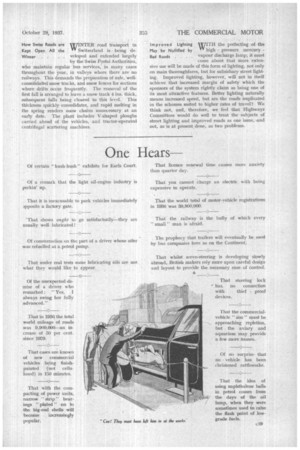Pass ing Comments Would Automatic Extinguishers be Practicable for Vehicles? .
Page 80

Page 81

If you've noticed an error in this article please click here to report it so we can fix it.
. AWRITER in the September issue of the Institute of Consulting Motor Engineers, referring to the influence of design on fatalities due to fires in motor vehicles, suggests that present electrical systems leave much to be desired in the matter of immunity from fire following collision. He suggests that a universal change from spirit to oil fuel would be of some help, and that adequate fire-extinguishing apparatus should be mounted at danger points upon the vehicle, with automatic operation. He is also somewhat critical of magnesium alloys, whilst the automatic cutting-off of the electrical supply, preferably at its source, would, he considers, do much to enhance safety. We have seen several types of switch which would effect this in the case of a vehicle overturning, but not merely as the result of a collision, although it should not be difficult to produce such devices.
c18
Interesting ExperiCONSIDERABLE progress is ments with Steelbeing made with the spraysprayed Crankshafts big of metal upon various sur
faces, particularly those subject to wear. A paper on the subject was read at Manchester on October 20, before the Association of Metal Sprayers. Tests carried out with sprayed-steel shafts running in white-metal bearings gave interesting results. The bearings were first lubricated with colloidal-graphited oil. After cutting off the oil supply steel shafts seized in about three hours, but a sprayed shaft ran for 22i hours before seizure ; then, after an hour's rest, it ran for another three hours. Experiments were carried out with crankshafts from 22 different engines. The crankshafts were reduced on half the journals to about below size, and built up by spraying with steel, which, after finishing, gave
a thickness of about On petrol engines journal wear was 15 per cent. less, and in oil engines half. How Swiss Roads are WINTER road transport in . Kept Open An the vv Switzerland is being de Winter veloped and extended largely
by the Swiss Postal Authorities, who maintain regular bus services; in many cases throughout the year, in valleys where there are no railways. This demands the preparation of safe, wellconsolid.ated snow tracks, and snow fences for sections where drifts occur frequently. The removal of the first fall is arranged to leave a snow track 4 ins, thick, subsequent falls being cleared to this level. This thickness quickly consolidates, and rapid melting in the spring renders snow chains unnecessary at an early date. The plant includes V-shaped ploughs carried ahead of the vehicles, and tractor-operated centrifugal scattering machines.
Improve d Lighting WITH the perfecting of the May be Nullified by " high pressure mercury Bad Roads . . . vapour discharge lamp, it must come about that more extensive use will be made of this form of lighting, not only on main thoroughfares, but for subsidiary street lighting. Improved lighting, however, will not in itself achieve that increased margin of safety which the sponsors of the system rightly claim as being one of its most attractive features. Better lighting naturally means increased speed, but are the roads implicated in the schemes suited to higher rates of travel? We think not, and, therefore, we feel that Highways Committees would do well to treat the subjects of street lighting and improved roads as one issue, and not, as is at present. done, as two problems.
























































































































































































